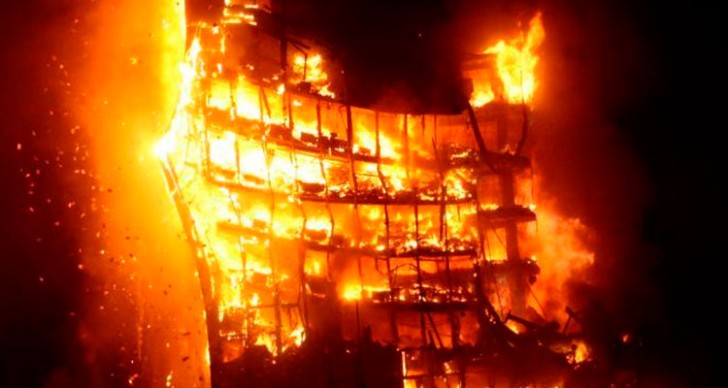Today we present a summary of the most important aspects of fire resistance of structures and a simple example.
A fire is an accident, it is a conversion of the energy of a combustible matter into heat within an enclosure whose structure is what we try to defend.
There is a need for combustible matter, ignition, and further development. It really is a complex phenomenon, but for our purpose, we only need a fire curve (temperature-time) that applies to the whole enclosure at the same time and a minimum time requirement that the structure must resist without collapsing.
The curve in most cases is the standard ISO 834. The minimum FR time in minutes that is required is set by the applicable codes or by the authority and serves many reasons (structure class, fire load, size of the sector, accessibility, active measures, etc.) that are out of reach here. For example, if the requirement ("rating") is FR30, it has to resist 30 minutes to that type of fire without the structure collapsing.
As long as the time until the collapse exceeds this value, we have completed our mission. That requirement ("rating") is supposed to be adequate to allow the intervention of firefighters, practice rescues, isolate areas, prevent the flame spread and so on.
Simplified Method
The effect of a developed fire (there are other types) is to produce flames and fumes that, among other things, heat the structure by radiation and convection. It is a complex phenomenon because it varies in space and time, modifying its properties and introducing deformations and stresses.
Sometimes, the best is the enemy of the good. Hereunder the simplified Eurocode Method will be explained. There are other advanced methodologies, with tests and analysis through CFD and FEM, the fire curve is not conventional, it is determined in each case and also the structure is analyzed over time by coupling the thermal and mechanical responses.
The simplified method is conservative, but if well applied, it is very efficient and fast. It is based on the concept of Critical Temperature. With this method, the passive protection can be adjusted and we can overcome the simplistic position, ultramontana, and sometimes even deliberately exaggerated position that a steel structure fails when the temperature reaches 550°C. (However, there were times, when it was stipulated to be 500°C.)
Apart from a few exceptional cases (where it can be conclusively determined), the majority of structures resist higher temperatures. That is to say, the Critical Temperature is superior to 550 °C.
There are three clear facts:
- The variation of steel properties (fy,E) with different temperatures is well established.
- In the case of overground structures with common designs, the effects of thermal expansion can be disregarded. A decoupled mechanical and thermal response is considered. Cardington's life-size tests prove this point and the Eurocodes sanctify it.
- The loads in the event of an accident are taken realistically: constant actions without factoring and variable actions reduced (simultaneity coefficients φ<1). The current code is applied.
Example
Let's present a simple case by answering five key questions:
Let’s take a beam IPE 550, of S355JR steel, mounted on two supports with a 10 meter span (L= 10 meters).
In case of a fire, the constant load is 7.5 kN/m and the variable load is of 21 kN/m, with a simultaneity factor φ=0.7.
There's supposed to be no risk of lateral buckling.
1. What is the critical temperature of the beam?
The load is p = 7.5 + φ 21 = 22.2 kN/m
The bending moment M = p L2/8=77.5mkN
As the elastic modulus of the profile is W= 2441.5 cm3 the maximum stress will be s = M/W = 277.5 106 / 2441.5 103 = 113.7 N/mm2
Therefore the yield stress can be lowered by a proportion of:
μ= σ/fy = 113.7/355 = 0.32
This means that the temperature, as interpolated in the Eurocode table, can rise to 654°C (higher than the "usual"). This is the critical temperature.
2. How long can it withstand an ISO 834 type of fire without protection?
If it is completely surrounded by fire, the profile catalog indicates that its perimeter/area ratio is worth A/V =140 m-1.
Solving the differential thermal equation, or applying the APTA nomogram from the book of industrial units, a time of 18 minutes is obtained for that massivity factor and the critical temperature 654°C (at least it would comply with FR15).
3. What thickness of protection made of sprayed mortar of λ=0.12 W/m°K conductivity must be provided if FR90 is required?
Applying again the nomogram, the point corresponding to 90 minutes and to T= 654°C is where the curve 1200 passes approximately.
If (A/V) λ/d = 1200, the thickness of the protection is d=0.014 metros. 1.5 cm is a good fit.
4. What protection thickness should be used if it is stipulated that the critical temperature is also 550°C in case of FR90?
Applying again the nomogram, the point corresponding to 90 minutes and now T= 550°C is where the curve 800 approximately passes.
If (A/V) λ/d = 800, the protection thickness is d=0.021 meters.
Keep in mind that with this conservative position, to put it politely, you have to have 50% more thickness.
5. What thickness of intumescent paint should be applied rationally, i.e. considering 650°C, or if it is stipulated that the critical temperature is 550°C also in case of FR90?
Using the tables of the product "X1548 Intumescent Coating R60SB" for FR90 and entering with the massivity factor A/V= 140 m-1 you get 0.89 mm for 650°C and out of the table for 550°C (if there was at least a factor of 110 m-1 you should put 1.369 mm).
Keep in mind that unless you act upon common sense, intumescent paint may not be used unfairly.
References:
- Eurocódigo 3, parte 1.2 - Nomograma APTA (Asociación para la promoción técnica del acero) - “Naves Industriales con acero” 2a ed. A.Arnedo Pena. APTA 2009
